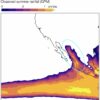Australia has a big problem with plastic waste, with millions of tons of household and industrial plastics breaking down in landfill, rivers and the sea every year.
Like mapping of the giant Pacific garbage patch, Flinders University is leading South Australian research into how degrading plastic waste is progressively building up in local coastal areas and the Gulf St Vincent, which covers vital marine park areas and commercial fisheries.
A new study uses microplastic density mapping—compiled over two years by experts at the South Australian Research and Development Institute (SARDI), the research arm of Primary Industries and Regions SA (PIRSA)—to raise concerns about rising microplastic particles in the Gulf. The study, “Modelling marine microplastics accumulation zones through freshwater discharge sources: Simulated release from the Onkaparinga River and Torrens River, South Australia,” has been published in the Marine Pollution Bulletin.
Flinders University Professor of Biological Oceanography Sophie Leterme says compounding pollution issues will continue to escalate in every part of the environment with plastic production predicted to double over the next 20 years in response to global population.
“Microplastics are manufactured using various toxic chemicals, are durable, pervasive and can absorb other harmful pollutants within the marine environment,” says Professor Leterme, from Flinders University’s Institute for NanoScale Science and Technology.
“Potentially, accumulation areas with high densities of microplastics in South Australian waters remain undiscovered—even though these particles are increasingly finding their way into marine trophic webs and are ingested by organisms.
“Ingestion of microplastics by humans is also a concern, including through contaminated food consumption.”
For this reason the researchers say the new system developed to monitor and measure microplastic accumulation in local waters and freshwater streams can be further adapted and adopted to local conditions.
SA’s marine economy was worth A$2.3 billion (2019), with the Gulf St Vincent (GSV) accounting for about half the value of production in marine industries.
Both Spencer Gulf and GSV are large semi-enclosed water bodies or inverse estuaries which means they become progressively saline as they go further inland. In GSV the residual (non-tidal) currents are predominantly wind driven—making their oceanographic conditions ideal for entrapping plastic debris.
Flinders University researchers Kyle Mitchell, Professor Leterme and Dr. Jason Gascooke worked with Dr. Charles James, from SARDI, to develop the new model.
The hydrodynamic model of the gulf currents was used to drive a particle tracking simulation of microplastics originating from two coastal freshwater input sources, the Onkaparinga and Torrens rivers. The results were used to map forecasted microplastic pollution densities in Gulf St Vincent, and identify potential microplastic accumulation zones.
The study also focused on simulating the trajectories of microplastic particles that could enter marine park boundaries in the gulf. Microplastics are smaller plastic particles (
More information:
Kyle B. Mitchell et al, Modelling marine microplastics accumulation zones through freshwater discharge sources: Simulated release from the Onkaparinga River and Torrens River, South Australia, Marine Pollution Bulletin (2023). DOI: 10.1016/j.marpolbul.2023.115334



